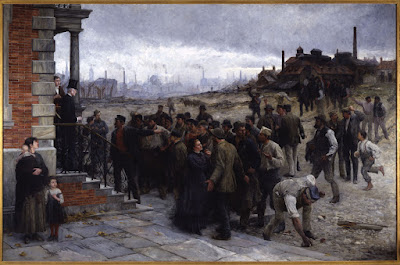Robert Koehler - Der Streik - 1886
The visual artist Robert Koehler (1850–1917) painted this scene in Munich. When it was exhibited in the United States in the spring of 1886, it made headlines. One can immediately sense that the confrontation between a factory owner (on the left, wearing a top hat) and a group of rebellious workers is on the verge of turning violent. The distance between the owner's elegant brick villa, where the employer is symbolically positioned on the steps, and the factory in the background has been intentionally shortened by the artist. This allows Koehler to highlight the workers who are streaming out of the factory to support the labor representative confronting the factory owner at the foot of the stairs. The tension of the situation is expressed through the posture and red shirt of the labor leader, not to mention the figure in the foreground armed with a stone. The stiff posture of the employer, accentuated by his black suit and top hat, suggests a lack of inclination towards compromise; even his own servant standing behind him seems fearful of what will come after the heated exchange.
This painting was created after Koehler had experienced the labor movement on both sides of the Atlantic. Born to German parents in Hamburg, Koehler moved to the United States as a child; the family settled in Milwaukee, one of the preferred destinations for German immigrants. Koehler studied art, especially lithography, in Pittsburgh and New York, and then attended the Academy of Fine Arts in Munich. When this painting was exhibited in the spring of 1886 at the National Academy of Design in New York, it was considered the most significant piece in the exhibition. Why? Because its exhibition coincided with the peak of American workers' demands for an eight-hour workday, accompanied by a wave of strikes involving about 350,000 workers in over 11,000 companies. Attempts to suppress these strikes culminated in the Haymarket Massacre in Chicago on May 4, 1886.
Source: germanhistorydocs.org


Comments
Post a Comment